On January 4, 2017, Two Harbors’s wonderful birding guru, Jim Lind, reported on eBird that there was a Eurasian Tree Sparrow hanging out with a flock of House Sparrows right in town. It may have been there earlier than that, because I later read an MOU listserv post by Kim Eckert saying it had first appeared in December.
We’ve had a handful of Eurasian Tree Sparrow records over the years in the southern third of the state and in extreme western Minnesota, but never before anywhere in northeastern Minnesota. And I’ve never seen one in the state. It’s so rare that I didn’t make even a cursory reference to it in my ABA Field Guide to the Birds of Minnesota.
People started scattering bird seed on the ground near the parking lot behind the Do North Pizzeria, in hopes that more people would be able to see the bird if it had a steady supply of food in one place.
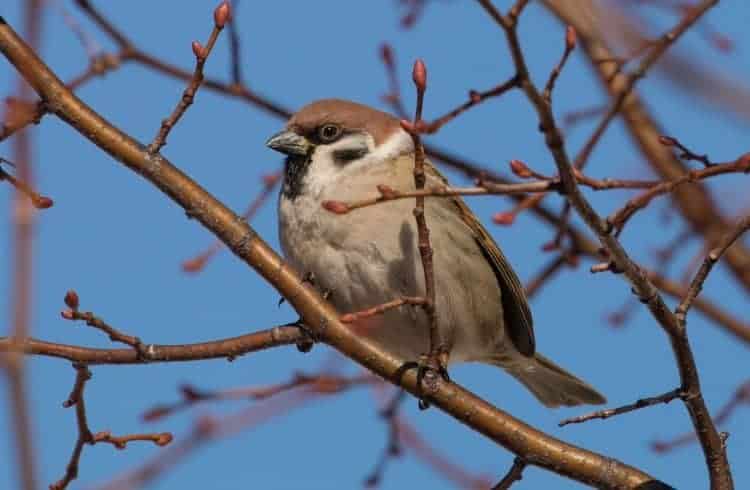
When Jim first reported it, I had whatever horrible flu or cold virus has been going around this year and was stuck at home. I felt better just in time for my trip to New York and D.C., but had a relapse on the trip home, so I was out for the count until early February.
Meanwhile, the sparrow disappeared for a couple of weeks, but suddenly turned up again on February 3. I went looking for it with my friend Karen Keenan on February 4, and headed out again the next day, Superb Owl Sunday with Lisa Johnson. We didn’t find any sparrows at all on either day.
On Monday, February 13, I headed back to Two Harbors with my dog Pip because so many clichés kept springing into my head, like “hope springs eternal,” “third time’s the charm,” and “if at first you don’t succeed, try, try again.”

We pulled into the parking lot behind the Do North Pizzeria, and voila! There in a small tree was a tiny flock of sparrows. Ten were House Sparrows, and there, right in the center of the flock, was the Eurasian Tree Sparrow.
The flock stayed up in the tree long enough for me to take almost a hundred photos, then dropped to the parking lot to pick at some grit under a couple of cars.
They ignored the cracked corn scattered at the base of the tree; after less than a minute under the cars, the flock flew off en masse.
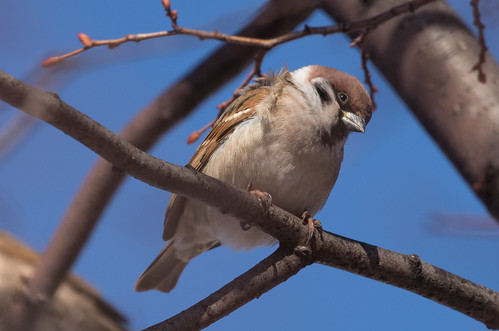
Eurasian Tree Sparrows are, as their name implies, native to temperate areas of Europe and Asia, all the way into Southeast Asia. They also have an established population in and around St. Louis, Missouri—that population reportedly began with 12 birds imported from Germany in April 1870 to be released in one of the old “naturalization” projects that introduced popular birds from all over the globe to new countries.
That small population hasn’t spread much, even as starlings introduced in New York City were spreading all over the continent. Eurasian Tree Sparrows are considered a pest species in Australia—they aren’t introduced intentionally there, but sometimes start nesting on ships in various ports in Southeast Asia and stay with the ship all the way to Australia.
I saw my very first Eurasian Tree Sparrow in St. Louis on October 28, 2004. I remember the date because it was the morning after the Boston Red Sox broke their curse by winning the World Series for the first time since 1918, routing the Cardinals in four games. The whole city of St. Louis seemed sorrowful, something even a lifelong Cubs fan could pick up on.

Now I have a very close friend who lives in Kirkland, right outside St. Louis, and I’ve visited her and seen Eurasian Tree Sparrows at her place a few times. Most recently was in 2013 when I was doing my Big Year.
I was driving home from New Mexico and Texas and stopped to see Susan and her Eurasian Tree Sparrows, which I needed for the year. I needed to get as far as Madison, Wisconsin that day, so I couldn’t stay long.
So Susan’s husband David painted a sign on a large piece of plywood, saying “ETS for Laura.” Sure enough, they were the very first birds I saw.


When I went to Europe in 2014, I saw Eurasian Tree Sparrows in Austria, Hungary, and Germany, where they belong.
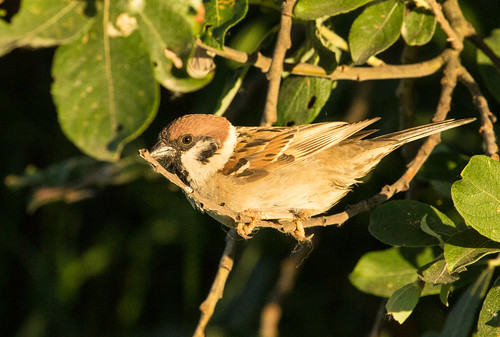
And I saw some in January 2015 in Quincy, Illinois, when I went down trying to find an Ivory Gull that had disappeared the day before.
That’s within the range of the population centered in St. Louis, but it was the first time I’ve ever seen them in Illinois.

We’ll never know where the Two Harbors sparrow came from, or why it wandered to the Do North Pizzeria in Two Harbors, Minnesota, so far from every known Eurasian Tree Sparrow on the continent.
Unless it heads back pretty soon, this one won’t fulfill its destiny of reproducing to ensure that the world continues to have Eurasian Tree Sparrows, unless it’s already been there, done that, and was searching for a new experience. For all we know, this one is pulling a Paul Simon, and gone off to look for America.
Or maybe it realizes it doesn’t have a green card and is desperately trying to reach the Canadian border before INS can track it down. If that’s the plan, will its next stop be Sven and Ole’s Pizza in Grand Marais?
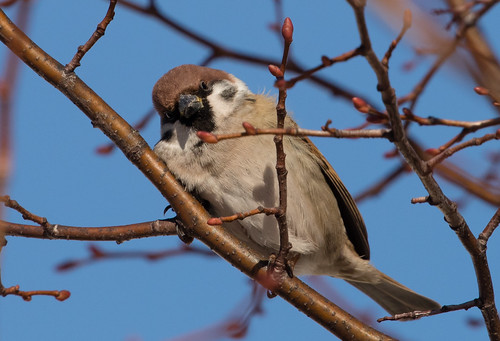
Laura Erickson
Laura Erickson, 2014 recipient of the American Birding Association’s prestigious Roger Tory Peterson Award, has been a scientist, teacher, writer, wildlife rehabilitator, professional blogger, public speaker, photographer, American Robin and Whooping Crane Expert for the popular Journey North educational website, and Science Editor at the Cornell Lab of Ornithology. She’s written eight books about birds, including the best-selling Into the Nest: Intimate Views of the Courting, Parenting, and Family Lives of Familiar Birds (co-authored by photographer Marie Read); the National Outdoor Book Award winning Sharing the Wonder of Birds with Kids; 101 Ways to Help Birds; The Bird Watching Answer Book for the Cornell Lab of Ornithology; and the National Geographic Pocket Guide to Birds of North America. She’s currently a columnist and contributing editor for BirdWatching magazine, and is writing a field guide to the birds of Minnesota for the American Birding Association. Since 1986 she has been producing the long-running “For the Birds” radio program for many public radio stations; the program is podcast on iTunes. She lives in Duluth, Minnesota, with her husband, mother-in-law, licensed education Eastern Screech-Owl Archimedes, two indoor cats, and her little birding dog Pip.

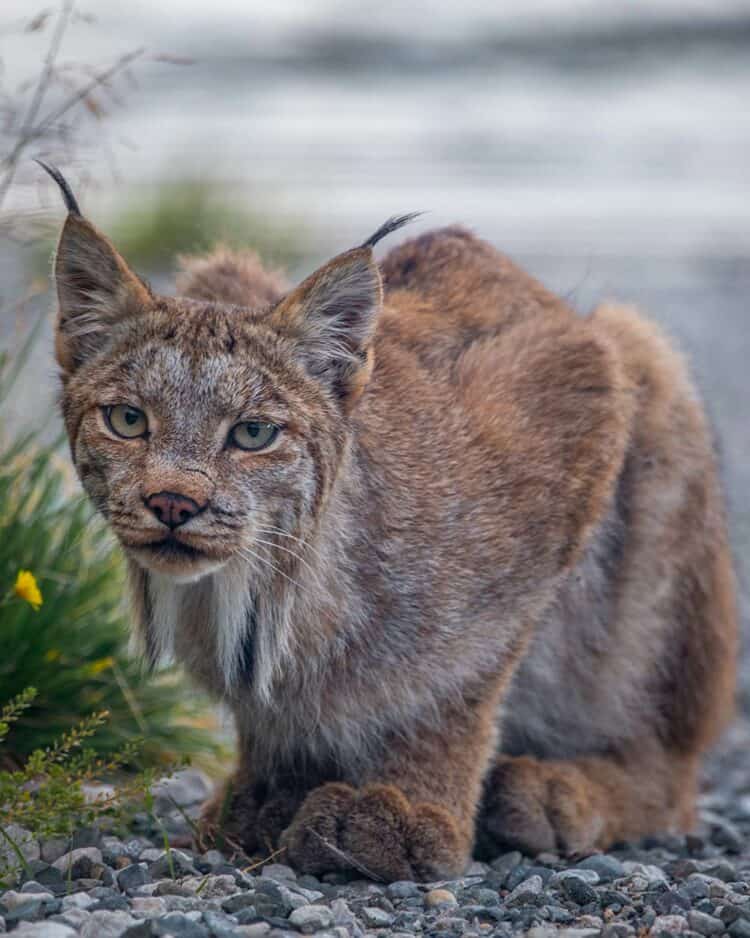

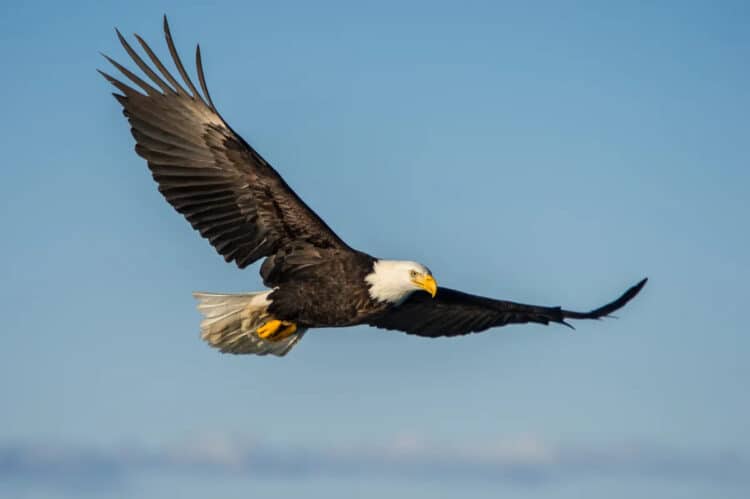
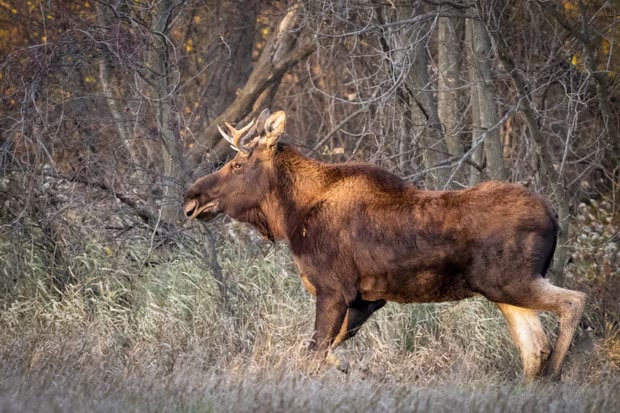
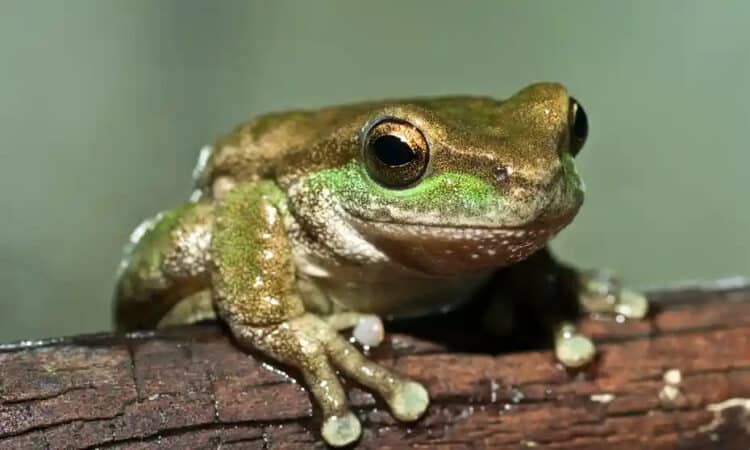
Leave a Reply